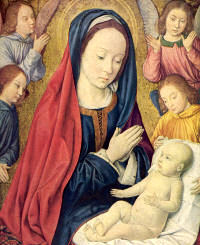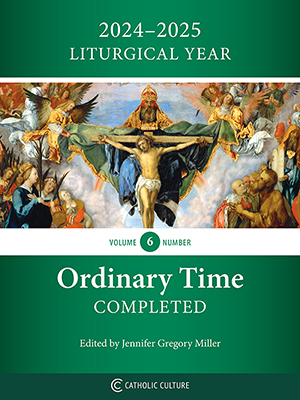Make your gift today!
Help keep Catholics around the world educated and informed.
Already donated? Log in to stop seeing these donation pop-ups.
Christmas: December 25th
Solemnity of Christmas
Other Commemorations: St. Anastasia, Martyr (RM);
» Enjoy our Liturgical Seasons series of e-books!
Today the Church celebrates the Birth of Jesus Christ, the first day in the octave of Christmas. Throughout Advent the Church longed ardently for the coming of our Savior. Today she celebrates His birth with unrestrained joy. "The Word was made flesh and dwelt among us." The Son of God became man to give us a share in that divine life which is eternally His in the Blessed Trinity. Christmas time begins on December 24 with the first Vespers of the feast and ends on the feast of the Baptism of Christ. White vestments reappear in our churches as a sign of joy.
Click here for commentary on the readings in the Extraordinary Form of the Roman Rite.
The Christmas feast is a festival full of joy. The Eternal Word has become Man and dwells among us. The longings of the patriarchs and prophets are fulfilled. 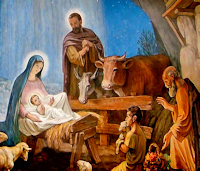 With the shepherds we hurry to the manger and adore the Incarnate Son of God, who for us and for our salvation descended upon earth. The purpose of the Christmas feast is beautifully expressed in the Preface of the Nativity: "For by the mystery of the Word made flesh the light of Thy glory hath shone anew upon the eyes of our mind; so that while we acknowledge Him a God seen by men, we may be drawn by Him to the love of things unseen."
With the shepherds we hurry to the manger and adore the Incarnate Son of God, who for us and for our salvation descended upon earth. The purpose of the Christmas feast is beautifully expressed in the Preface of the Nativity: "For by the mystery of the Word made flesh the light of Thy glory hath shone anew upon the eyes of our mind; so that while we acknowledge Him a God seen by men, we may be drawn by Him to the love of things unseen."
About Christmas
During the Christmas season there is an extensive exchange of greetings and good wishes among friends. These greetings are a reminder of those "good tidings of great joy that shall be to all the people, for this day is born to you a Savior Who is Christ the Lord" (Lk. 2:11). They are a reminder, too, that all blessings and graces come to us from Christ: "Hath He not also with Him given us all things?" (Rom. 8:32).
Typically there is also an exchange of gifts. This custom should recall to us that on this day God Himself gave to us the greatest of all gifts, His beloved Son: "God so loved the world as to give His only begotten Son" (John 3: 16).
The Christmas tree, of which the first-known mention was made in 1605 at Strasbourg, was introduced into France and England in 1840. 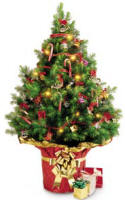 It symbolizes the great family tree of Christ which through David and Jesse has its roots in Abraham, the father of the chosen race. It is often laden with gifts to remind us that Christmas brought us the priceless gifts of grace and of eternal life. It is frequently adorned with lights that recall to us that Christ is the Light of the world enlightening those who sit in darkness and in the shadow of death.
It symbolizes the great family tree of Christ which through David and Jesse has its roots in Abraham, the father of the chosen race. It is often laden with gifts to remind us that Christmas brought us the priceless gifts of grace and of eternal life. It is frequently adorned with lights that recall to us that Christ is the Light of the world enlightening those who sit in darkness and in the shadow of death.
Though not entirely unknown before, the custom of the Christmas Crib or Creche was adopted by St. Francis of Assisi at Greccio, Italy, on Christmas 1225. It is a concrete and vivid way of representing to ourselves the Incarnation and birth of Christ. It depicts in a striking manner the virtues of the newborn Savior, especially His humility, poverty, and charity.
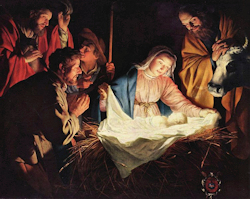
Catholic Culture offers these links to help you experience the joy of Christmas by keeping a spiritual focus on the season.
Throughout this wonderful time there will always be much hustle and bustle, shopping and baking and gift giving. But we hope you will refer to the Catholic Culture calendar often for ideas and spiritual nuggets to increase your Christmas joy.
Let us try to celebrate Christmas with the innocence and humility of children always keeping in mind the wonderful birth of the Christ Child.
Joy to the world the Lord has come, let earth receive her King.
Highlights and Things to Do:
- Christmas at Home and in the Liturgy
- Read about the The Masses of Christmas
- Put Christ Back in Christmas
- Listen to the Catholic Culture audiobook of St. John Henry Newman: The Special Charm of Christmas read by James Majewski.
Christmas—The First Day
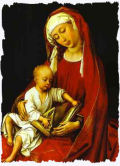 The purest of Virgins gave us our God, who was this day born of her, clothed in the flesh of a Babe, and she was found worthy to feed him at her Breast: let us all adore Christ, who came to save us.
The purest of Virgins gave us our God, who was this day born of her, clothed in the flesh of a Babe, and she was found worthy to feed him at her Breast: let us all adore Christ, who came to save us.
Ye faithful people, let us all rejoice, for our Savior is born in our world: this Day there has been born the Son of the great Mother, and she yet a pure Virgin.
O Queen of the world, and Daughter of a kingly race! Christ has risen from thy womb, as a Bridegroom coming from the bride-chamber: He that rules the stars lies in a Crib.
—Antiphon from the ancient Church of Gaul
- Day One Activity (Christmas Drama)
- Day One Recipe (Breton Nut Bread)
Meditation: Christmas: the Lord’s Birth
Today is the great solemnity that shows the world that the Word incarnate, the Savior of mankind, is finally born. God becoming truly man is an enormous event [….]. Something truly happens that goes beyond any evolutionary process: the fusion of man and God, the creature and the Creator. It is not the progression of another step in the evolutionary process, but the eruption of a personal action, founded on love, that from this point forward reveals to men new space and possibilities. (Joseph Ratzinger in God and the World: A Conversation with Peter Seewald, 2001, p. 197).
Christmas says to us: alone we can’t profoundly change the world to remedy it. Alone, we can make the world better or worse, but we can’t save it. Christ came therefore, because left to ourselves; we couldn’t escape the ‘mortal disease’ that has enveloped us from the first moment of conception in our mother’s womb. This gives us hope, true hope, and true Christian optimism: I can’t do it but He is there! This is the mystery of grace synthesized in the human figure of God incarnate.
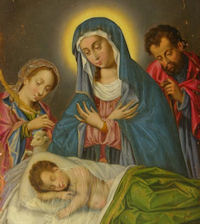
Christmas Eve and Christmas day are moments of contemplation. We consider, in many dimensions, the mystery of love that was incarnated for us. First of all, we contemplate the light and joy, without forgetting Jesus and Mary’s sorrows and sufferings, and the many difficulties that had surrounded them: the cold, the uncomfortable place, the dangers….. It would be good to accompany these thoughts by reciting and meditating slowly on the Holy Rosary, preferably in front of a crib. ‘Blessed grotto of Bethlehem that testified to the wonders! Who, in this hour would not turn our hearts? Who would not prefer the opulent palace of the King?’ (P. Guéranger, L’Anno Liturgico, Alba 1959 [orig. franc. 1841], I, p122).
Listen to the way that St Bonaventure, the seraphic doctor, invites us to contemplate this scene in his ‘Meditation on the life of Jesus Christ’: You have also lingered, bent your knee, adored the Lord God, venerated His Mother and greeted Joseph, the holy old man, with reverence. Therefore, kiss the feet of the baby Jesus, who lies in the manger, and pray that the Holy Virgin will allow you to hold Him. Take Him between your arms, hold Him and see His lovable face, kiss it with reverence and rejoice with Him. You can do this because He has come to bring salvation to sinners and He has humbly conversed with them, finally giving Himself as food' (cit. in Guéranger, pp 136-137).
Christmas also reminds us of the great mystery of God’s people, of the Church acquired through Christ’s blood, animated by the life giving Spirit, governed by the legitimate shepherds in communion with the successor of Peter. On this day in which the Word came to earth, assuming human nature, body, and soul, how can we not think about His Mystical Body that is animated by the Holy Spirit? ‘For this reason, by no weak analogy, [the Church] is compared to the mystery of the incarnate Word. As the assumed nature inseparably united to Him, serves the divine Word as a living organ of salvation, so, in a similar way, does the visible social structure of the Church serve the Spirit of Christ, who vivifies it, in the building up of the body’ (Vatican II, Lumen Gentium, n.8).
Holy Christmas also reminds us of the mystery of Mary as Mother of God, mother of the Incarnated Word, and mother of His mystical body, the Church. Christmas encourages us to contemplate Jesus together with Mary, reflecting on Jesus with ‘His mother’, as recounted many times in the Gospels. If our faith must be fully evangelical, it can not neglect a sane and profound devotion to the Mother of God, as she shows us the easiest way to reach Jesus.
—From the Dicastery for the Clergy
St. Anastasia
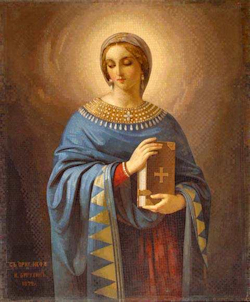 We include St. Anastasia's commemoration because the Station for the second Mass of Christmas, Mass at Dawn, is with St. Anastasia, in the Roman Church Sant'Anastasia al Palatino.
We include St. Anastasia's commemoration because the Station for the second Mass of Christmas, Mass at Dawn, is with St. Anastasia, in the Roman Church Sant'Anastasia al Palatino.
Anastasia was martyred at Sirmium in Dalmatia (today's Sremska Mitrovica in Serbia), probably under Diocletian, but only worthless legends have survived concerned her. She was venerated in Rome in the fifth century and, under the influence of Byzantine officials there (Anastasia's relics had been translated to Constantinople), her memory became associated with the second Mass of Christmas; she is still commemorated at that Mass in the Roman Missal, though the Byzantines keep her feast on December 22. She is named in the canon of the Mass.
—From A Dictionary of Saints by Donald Attwater
Patronage: martyrs; weavers; widows; Borgorose, Italy
Symbols and Representation: woman with palm branch of martyrdom; woman holding a small cross and vase; woman with a flame in her hand; woman holding a bowl with a flame in it
Highlights and Things to Do:
- Read more about St. Anastasia:
- See Christian Iconography for artistic renderings of St. Anastasia.
- St. Anastasia's relics were transferred to Constantinople In the 5th century, where a church was built and dedicated to her. Later, the relics, including her skull, were transferred to the Monastery of St. Anastasia the Pharmokolitria, Chalkidiki of Greece, near Mount Athos. In 2012, the relics were stolen and have not been recovered. (see story).
- Enjoy the virtual tour of St. Anastasia chapel in the Crypt Church of the Basilica of the National Shrine of the Immaculate Conception in DC.
- Read below about the station church for the Mass at Dawn.
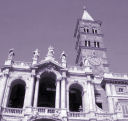
The Solemnity of the Nativity the Lord, At Night (First Mass of Christmas) and Mass During the Day (Third Mass of Christmas)
Station with Santa Maria Maggiore ad praesepe (St. Mary Major at the Crib):
The feast of Christmas is distinguished by a threefold celebration of the Mass. The old Romans imitated a venerable custom of the Church at Jerusalem. There the Christians assembled at the Nativity Grotto in Bethlehem and consecrated the hour of the Lord's birth by the celebration of a night Mass. Thereupon they returned to Jerusalem, arriving at early dawn. Nothing seemed more fitting than to spend that hour commemorating the resurrection in the church of the Resurrection, keeping Christmas with the shepherds. This was their second Mass.
On the day itself they would gather again in Jerusalem's main church for the Mass. Thus originated the custom of three Masses on Christmas. When the custom was adopted in Rome, the first, or midnight mass was held in Mary's church of the Crib (St. Mary Major meant Bethlehem to the Roman Christians); the second Mass was celebrated at St. Anastasia's; and the day's final liturgy took place back originally at St. Peter's, but it became St. Mary Major. From Rome the custom spread throughout the West; and when priests began to offer holy Mass daily, it became customary for every priest to celebrate three Masses on Christmas.
The Station is at St. Mary Major's, for the Mass at Dawn add ad praesepe, that is, "at the Crib." In this basilica is a model of the Crib of Jesus, dating from at least the time of Sixtus III (432-440). In the seventh century, a relic from the Crib at Bethlehem was placed there. To the Romans, St. Mary Major represented "Bethlehem". Our gaze is fixed on the crib which has become the throne of the God-man. The Third Mass, Mass During the Day is just at St. Mary Major's without mention of the crib.
For more on Santa Maria Maggiore, see:
For further information on the Station Churches, see The Stational Church.
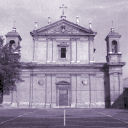
The Solemnity of the Nativity the Lord, Mass at Dawn (Second Mass of Christmas)
Station with Sant'Anastasia al Palatino (St. Anastasia of Palatine):
Today's stational church is St. Anastasia, dedicated to the early 4th century martyr St. Anastasia of Sirmium, who is included in the Roman Canon. The Mass of the Aurora or Dawn on Christmas Day was celebrated, often referred to as the Mass of the Shepherds. The Church of St. Anastasia was the Greek palace church (anastasis means "resurrection"). The Mass has the themes of the rising sun and the shepherds' visit to the crib. All about us is light as amazed we behold the newborn King of the world. Pope Francis granted the church to the Syro Malabar Church in July 2020.
For more on Sant'Anastasia al Palatino, see:
For further information on the Station Churches, see The Stational Church.


